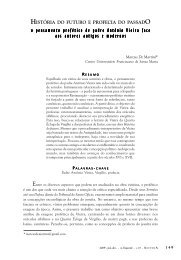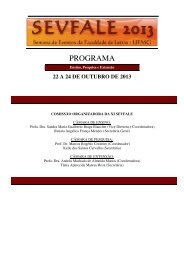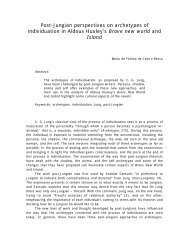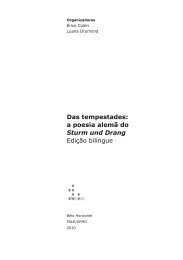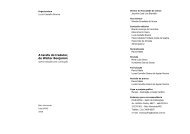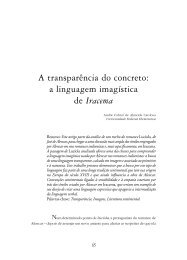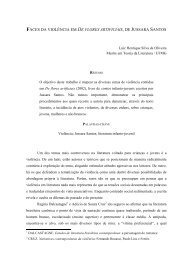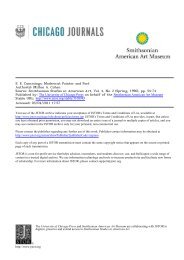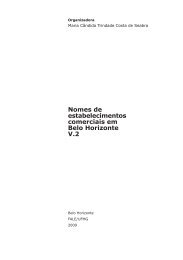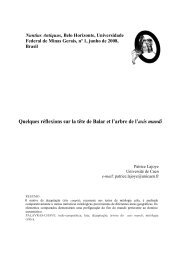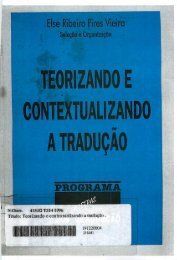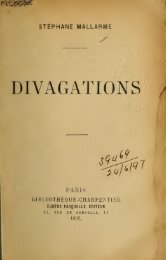Contornos do Indizível: o estilo de Clarice Lispector - Fale - UFMG
Contornos do Indizível: o estilo de Clarice Lispector - Fale - UFMG
Contornos do Indizível: o estilo de Clarice Lispector - Fale - UFMG
Create successful ePaper yourself
Turn your PDF publications into a flip-book with our unique Google optimized e-Paper software.
Em Tese, Belo Horizonte, v. 10, p. 60-66, <strong>de</strong>z. 2006<br />
culture and i<strong>de</strong>ntity. If I use the word “inconsistency,” I <strong>do</strong> so not in negative terms,<br />
nor conveying the i<strong>de</strong>a of disor<strong>de</strong>r and confusion in opposition to the logic maintained<br />
by a map. On the contrary, inconsistency here carries the notion of movement that<br />
creates the condition for negotiation and re-invention of i<strong>de</strong>ntities as it <strong>de</strong>stabilizes the<br />
rigid relation of place and self. The notion of inconsistency that I use matches Wisker’s<br />
use of the term “unsettling” to <strong>de</strong>scribe the movement of postcolonial subjects in the<br />
sense that, “[p]ost-colonial migrants both unsettle and enrich what was thought of as<br />
the centre of imperial powers” (16). As Wisker points out, inconsistency can also be<br />
felt in the relation between the migrant and the center of power, as she shows that<br />
migrants unsettle, but also enrich, power relations. Out of this ambivalent relationship,<br />
Wisker believes that it is the task of diasporic and migrant writers to “reflect on,<br />
record, imagine beyond, and articulate newly changed, merged, differently focused<br />
perspectives on their a<strong>do</strong>ptive cultures, and their position as writers with multiple roots<br />
in the history of several cultures.”<br />
The fact that Jhumpa Lahiri is the child of Indian immigrants and that she also<br />
crosses bor<strong>de</strong>rs when she migrates from England — where she was born — to become<br />
an American citizen makes her both a migrant and diasporic writer. 1 In her work, she<br />
reflects on the Indian diaspora and creates a narrative that reveals the inconsistency of<br />
the concepts of i<strong>de</strong>ntity and gen<strong>de</strong>r roles in the space of diaspora. Thus, it is my<br />
intention to discuss the attempt of hegemonic discourses to solidify notions of space,<br />
roles and i<strong>de</strong>ntities on a map, and the way Lahiri transforms these notions into fluid<br />
spaces when she portrays diasporic experiences in her book of short stories,<br />
Interpreter of Maladies, and in her novel, The Namesake.<br />
In my title I speak of cartography — and of its reinvention — for two different<br />
reasons. First, the term cartography is used to call attention to the map imagery in<br />
Lahiri’s works. Second, to discuss the attempts of hegemonic discourses to “map,” or<br />
to <strong>de</strong>termine fixed roles and i<strong>de</strong>ntities to different groups of people. The map imagery<br />
in both Lahiri’s book of short stories and novel questions the very meaning of the act<br />
of mapping. For instance, many of Jhumpa Lahiri’s characters turn to a map in an<br />
attempt to locate, experience and un<strong>de</strong>rstand India. For them, un<strong>de</strong>rstanding is closely<br />
connected to locating, or visualizing what they cannot experience, and a map seems to<br />
be a good starting point, especially because they are believed to offer a real and<br />
accurate representation of the world. As an example, in the episo<strong>de</strong> when Lilia — a<br />
second-generation Indian and the main character of Lahiri’s short story “When Mr.<br />
Pirzada came to Dine” — calls Mr. Pirzada an Indian, her father’s reaction is to take her<br />
to a map so she can un<strong>de</strong>rstand the “current situation” of India. What he means by the<br />
“current situation” are the conflicts between India and Pakistan after the Partition, but<br />
the simple division of the territories of India and Pakistan in a map is not enough to<br />
explain difference to Lilia, as she states:<br />
It ma<strong>de</strong> no sense to me. Mr. Pirzada and my parents spoke the same language, laughed at<br />
the same jokes, looked more or less the same. […] Nevertheless my father insisted that I<br />
un<strong>de</strong>rstand the difference, and he led me to a map of the world taped on the wall over his<br />
<strong>de</strong>sk. He seemed concerned that Mr. Pirzada might take offense if I acci<strong>de</strong>ntally referred<br />
to him as an Indian. (Interpreter 25)<br />
When Lilia tries to un<strong>de</strong>rstand the difference between her father and Mr. Pirzada,<br />
she shows that the organization of the world — or the division of people in<br />
homogeneous and distinct groups — is not solid and fixed like the structure of a map.<br />
On the other hand, this organization comes to be a fluid one that allows imaginable<br />
encounters, as Lilia testifies the encounter of a Muslim and a Hindu having dinner<br />
Disponível em http://www.letras.ufmg.br/poslit<br />
61



